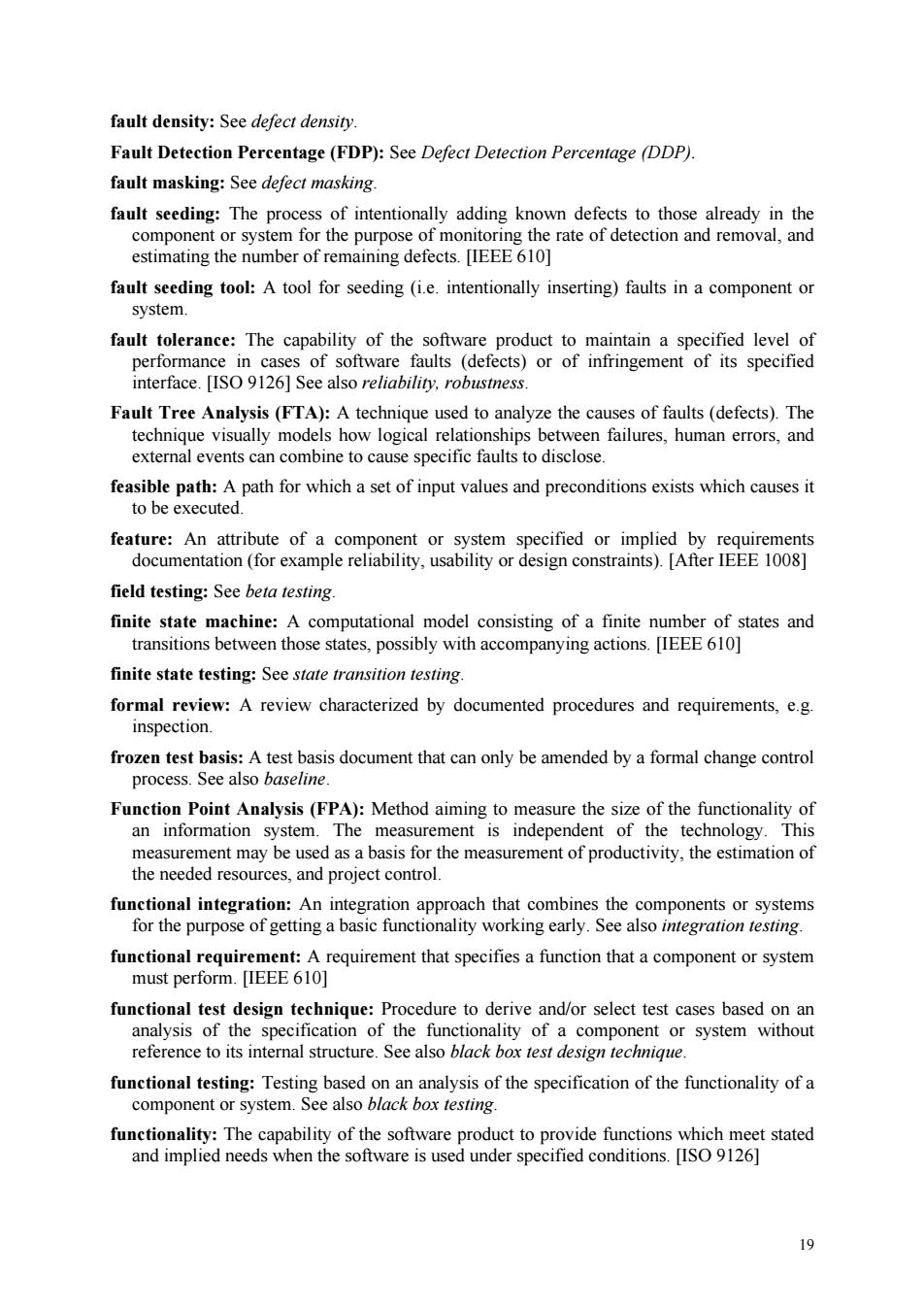正在加载图片...

fault density:See defect density. Fault Detection Percentage(FDP):See Defect Detection Percentage DDP) fault masking:See defect masking. fault seeding:The process of intentionally adding known defects to those already in the component or system for the purpose of monitoring the rate of detection and removal,and estimating the number of remaining defects.[IEEE 610] fault seeding tool:A tool for seeding (i.e.intentionally inserting)faults in a component or system. fault tolerance:The capability f the prod uct to mal intain a specified level s specified Fault Tree Analysis (FTA):A technique used to analyze the causes of faults(defects).The technique visually models how logical relationships between failures,human errors,and external events can combine to cause specific faults to disclose. feasible path:A path for which a set of input values and preconditions exists which causes it to be executed. field testing:See beta testing finite state machine:A computational model consisting of a finite number of states and transitions between those states,possibly with accompanying actions.[IEEE 610] finite state testing:See state transition testing. frozen test basis:A test basis document that can only be amended by a formal change control process.See also baseline. Function Point Analysis(FPA):Method aiming to measure the size of the functionality of an information system.The measurement is independent of the technology.This the mcded reand pet the measurement of productivity,the estimation of ach that comhines the for the purpos sis functionality working early.See als ms functional requirement:A requirement that specifies a function that a component or system must perform.[IEEE 610] functional test design technique:Procedure to derive and/or select test cases based on an analysis of the specification of the functionality of a component or system without reference to its internal structure.See also black box test design technique. componen functionality:The capability of the software product to provide functions which meet stated and implied needs when the software is used under specified conditions.[ISO 9126] 9 19 fault density: See defect density. Fault Detection Percentage (FDP): See Defect Detection Percentage (DDP). fault masking: See defect masking. fault seeding: The process of intentionally adding known defects to those already in the component or system for the purpose of monitoring the rate of detection and removal, and estimating the number of remaining defects. [IEEE 610] fault seeding tool: A tool for seeding (i.e. intentionally inserting) faults in a component or system. fault tolerance: The capability of the software product to maintain a specified level of performance in cases of software faults (defects) or of infringement of its specified interface. [ISO 9126] See also reliability, robustness. Fault Tree Analysis (FTA): A technique used to analyze the causes of faults (defects). The technique visually models how logical relationships between failures, human errors, and external events can combine to cause specific faults to disclose. feasible path: A path for which a set of input values and preconditions exists which causes it to be executed. feature: An attribute of a component or system specified or implied by requirements documentation (for example reliability, usability or design constraints). [After IEEE 1008] field testing: See beta testing. finite state machine: A computational model consisting of a finite number of states and transitions between those states, possibly with accompanying actions. [IEEE 610] finite state testing: See state transition testing. formal review: A review characterized by documented procedures and requirements, e.g. inspection. frozen test basis: A test basis document that can only be amended by a formal change control process. See also baseline. Function Point Analysis (FPA): Method aiming to measure the size of the functionality of an information system. The measurement is independent of the technology. This measurement may be used as a basis for the measurement of productivity, the estimation of the needed resources, and project control. functional integration: An integration approach that combines the components or systems for the purpose of getting a basic functionality working early. See also integration testing. functional requirement: A requirement that specifies a function that a component or system must perform. [IEEE 610] functional test design technique: Procedure to derive and/or select test cases based on an analysis of the specification of the functionality of a component or system without reference to its internal structure. See also black box test design technique. functional testing: Testing based on an analysis of the specification of the functionality of a component or system. See also black box testing. functionality: The capability of the software product to provide functions which meet stated and implied needs when the software is used under specified conditions. [ISO 9126]